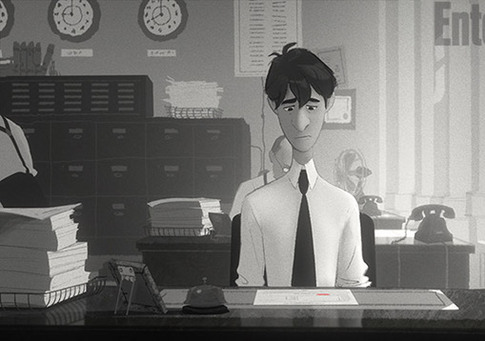28 February 2013
Directed By: John Kahrs
Starring: John Kahrs, Jeff Turley, Kari Wahlgren
What It’s About: A young man finds love with the help of a sheet of paper.
Rated G
Runtime: 7 minutes
By Cole Nelson, Staff Writer
Before every animated feature, Disney’s loyal audience has the opportunity to enjoy an animated short, whether it be an old man battling himself at chess, or a group of birds crowded onto one telephone wire. Ever since the creation of the Walt Disney Animation Studios, the company has had a history of short films, but now Disney has a chance to make history with its Oscar-winning short film Paperman.
Set in what seems to be present-day New York City (or some other bustling American city where the people are plenty), this six-and-a-half minute film follows a young, scrawny man who works at a desk and appears to lack interest in his life. While standing alone at the subway station, a single sheet of paper wisps against the man’s shoulder and is immediately followed by a young woman, the paper’s assumed owner. Little is thought of this until a sheet of the man’s work papers flies out of his folder and lands on the girls face, leaving an imprint of her lipstick. They exchange a quick chuckle then the two, once again, resume their separate lives. The twig of a man now sits at his boring desk, staring at the single piece of stained paper. A gust of wind nearly blows the paper out the window, leading his gaze across the street at an adjacent building. Whom does he see? None other than the beautiful girl he was standing next to earlier at the subway. From then on, the man attempts to get the women’s attention using his endless stack of work papers.
The story of Paperman is an original and fairly mature one (at least for Disney) that deals with the brief daily encounters that mean nothing if not acted upon. The entire film is played out with the characters’ actions and facial expressions, for it lacks something that Disney short films have typically used in the past: some sort of implied dialogue.
Comparable to Disney’s beginnings, Paperman also lacks color; it is shown in classic black and white with the exception of the red lipstick imprint left by the woman on the man’s paper, similar to Steven Spielberg’s Schindler’s List. Although not as solemn and poignant as Schindler’s List, Paperman does carry the same impacting sentiment with its distinct color scheme.
While most of Disney’s shorts have a somewhat childish look to them, Paperman has a peculiar reality in its animated style. The lighting, shadows, objects and their movements seem to be more lifelike than typical animated shorts—everything except for the characters.
Neither the man nor woman is given a name, allowing the audience to relate to the situation. The short film’s universality provides a powerful attraction to its viewers as a beautiful presentation of singular events than can drastically change a life, an idea that anyone can acknowledge as true.
Paperman is a fantastically executed short film and is well-deserving of its nomination and win for Animated Short Film Oscar. Disney took a risk by mixing things up, but it was all for the better.
Photo courtesy of www.joannagoddard.blogspot.com

